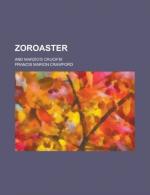She broke off with a pretty motion of her shoulders, showing her white teeth and turning to look at Gianbattista. Then the young man took them to see the grating. A good portion of it was put up, and it produced a good effect. The whole thing was about ten or twelve feet high, consisting of widely-set gilt bars, between which were fastened large arabesques and scrolls. On each side of the gate, in the middle, an angel supported a metal drapery, of which the folds were in reality of separate pieces, but which, as it now appeared, all screwed together in its place, had a very free and light effect. It was work of a conventional kind and of a conventional school, but even here Marzio’s great talent had shown itself in his rare knowledge of effects and free modelling; the high lights were carefully chosen and followed out, and the deep shadows of the folds in dull gold gave a richness to the drapery not often found in this species of decoration. The figures of the angels, too, were done by an artist’s hand—conventional, like the rest, but free from heaviness or anatomical defects.
“It is not bad,” said Don Paolo, in a tone which surprised every one. He was not often slow to praise his brother’s work.
“How, not bad? Is that all you say?” asked Gianbattista, in considerable astonishment. He felt, too, that as Marzio and he worked together, he deserved acme part of the credit. “It is church decoration of course, and not a ‘piece,’ as we say, but I would like to see anybody do better.”
“Well, well, Tista, forgive me,” he answered, “The fact is, Marzio showed me something to-day so wonderful, that I see no beauty in anything else—or, at least, not so much beauty as I ought to see. I went in to find him again, you know, just as Lucia was leaving, and he showed me a crucifix—a marvel, a wonder!—he said he had had it a long time, put away in a box.”
“I never saw it,” said Tista.
“I did!” exclaimed Lucia. She regretted the words as soon as she had spoken them, and bit her lip. She had not told her mother what she had told Gianbattista.
“When did you see it? Is it so very beautiful?” asked the Signora Pandolfi.
“Oh, I only saw it through the door, when I went,” she answered quickly. “The door was open, but I knocked and I saw him hide it. But I think it was very fine—splendid! What did you talk about, Uncle Paolo? You have not told us about your visit. I whispered to you that everything was settled, but you looked as though you did not understand. What did you say to each other?”
“Oh, nothing—nothing of any importance,” said Don Paolo in some embarrassment. He suddenly recollected that, owing to his brother’s strange conduct, he had left the studio without saying a word about the errand which had brought him. “Nothing,” he repeated. “We talked about the crucifix, and Marzio gave a very long explanation of the way it was made. Besides, as Lucia says, she had told me that everything was settled, and Marzio spoke very quietly.”




